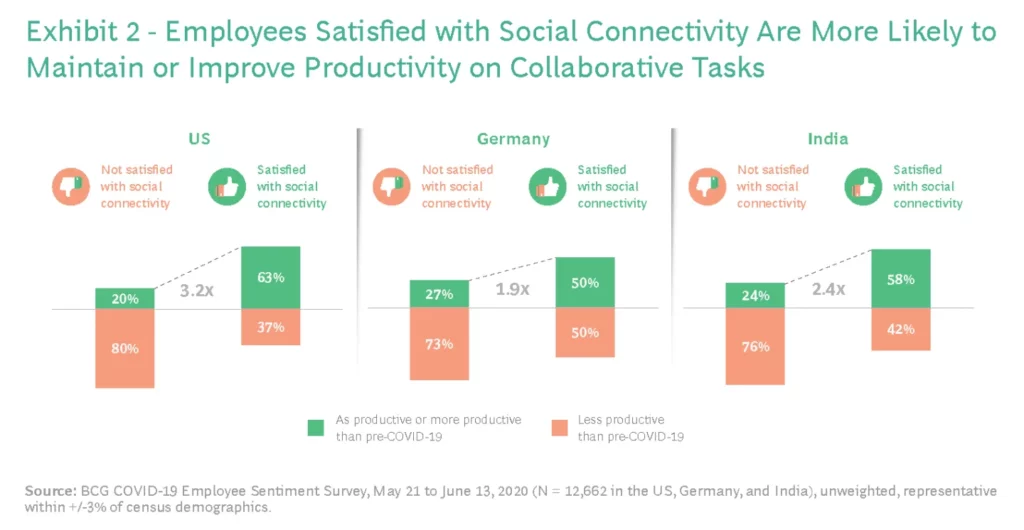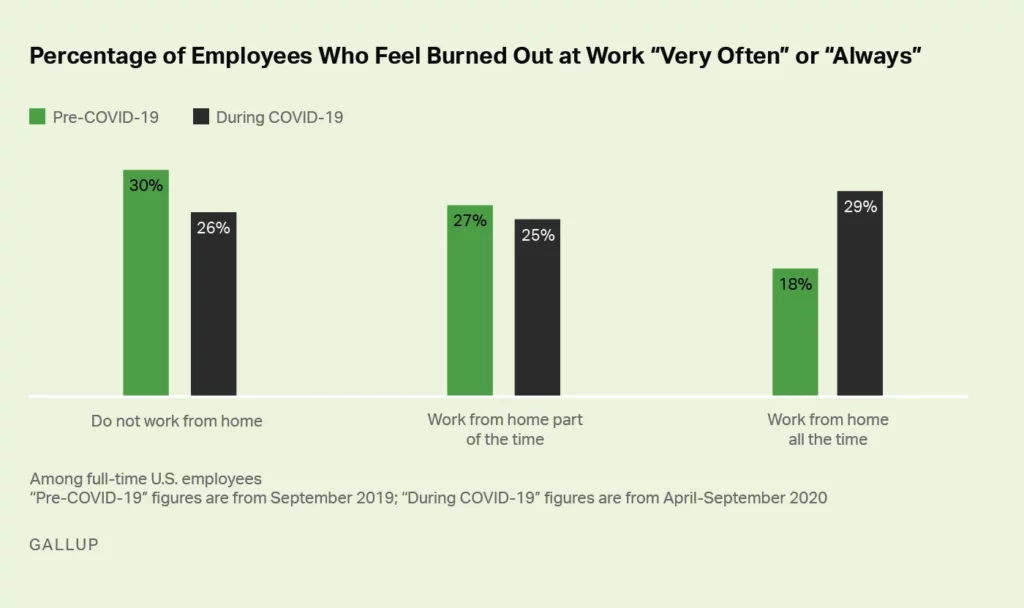Overcoming 6 Satanic Challenges in Managing Remote Employees
“Successfully working from home is a skill, just like programming, designing or writing. It takes time and commitment to develop that skill, and the traditional office culture doesn’t give us any reason to do that.”
Until the end of 2019, work from home was a movement. Working from home was a perk. Managers were usually hesitant to offer work from home options. Remote working opportunities were scarce. Owl Labs revealed that 1 in 5 employees was willing to take a pay cut of more than 10% if they are allowed to work remotely. Also, there were fewer challenges in managing remote employees.
Enter 2020 and the pandemic. Three months in, several million workers were forced to set up home offices. Zoom became a verb. Virtual parties were normalised. The first quarter of 2020, marked an unprecedented rise in employees working from home. And so did the challenges in managing remote employees.
Suddenly, all was not well for managers. There entered new challenges in managing employees remotely. The pandemic tested everyone — budding, mid-level and stalwart managers, alike. A study published in HBR, revealed that 40% of the 215 supervisors and managers the study surveyed expressed low self-confidence in meeting the challenges of managing remote employees.
New challenges cropped up for the manager of the post-pandemic era. BCG’s survey of over 2,000 employees revealed that 79% experienced anxiety, loneliness and several instances of work encroaching their private times. Hence, managers began to deal with issues pertaining to their employees’ mental health. They also had to deal with miscommunication and distrust more than other issues.
In Numbers: The toughest challenges with managing virtual workers
Several studies show that remote workers are plagued by 3 dominant issues – loneliness, anxiety, isolation – the overarching theme being poor interpersonal relationships.
- 19% of remote employees report loneliness as their biggest challenge. (Source: Buffer)
- 22% of remote employees feel that working from home has blurred lines between work and family time. (Source: Buffer)
- Employees dissatisfied with social connectivity perform terribly on collaborative tasks. (Source: BCG Report)
- 54% believe to be at greater cybersecurity risk when they work from home. (Source: Open VPN)
- Martec Group pointed out that advantages like flexible schedules, no commute and fewer distractions do not supersede resulting mental health concerns. Over 40% of Martec’s survey respondents suffered from stress, reduced focus and productivity.
Numerous studies point out the increased productivity and economic benefits of working remotely. Studies do reveal that the productivity benefits outnumber negative impacts such as stress, poor mental health etc.
However, in the long run, all these factors are related.
Robust productivity can be maintained only when employees are in good mental and physical shape. For collaboration to strengthen, communication is key. For employees to work towards a common goal, trust is vital.
Our research yielded 6 themes pertaining to the challenges in managing remote employees. Often, the key is to build strong and dynamic interpersonal relationships. Now, that’s simple.
However, the primary challenge in managing remote workers is that you’ll have to pursue via virtual means to do the same.
The 6 Mean Managerial Challenges ( And Their Solutions)
1. Helping Employees Unplug
Remote employees face a unique challenge. Of course, there are infrastructural and functional issues. But something viler has stealthily crept into the lives of employees working from home.
It is the inability to unplug.
Let me explain.
Your employees have greater flexibility when working from home, isn’t it? They log in and log off whenever they want. As long as the task is ticked off, everyone is happy.
But, are they?
Researchers at the National Bureau Of Economic Research, analysed more than 3 million workers worldwide to find work from home attitudes. They too pointed out this stark delineation between the office and home due to loosely regulated, flexible work hours.
Higher levels of flexibility lead to lesser focus. Lesser focus leads to working over chunks of hours leading to higher perceived productivity. However, in reality, employees seem to never disconnect from work, spilling their office hours into their personal life.
To manage this challenge with remote employees, try these steps.
Solutions:
- Strongly encourage employees to set up availability times.
- Set accountability partners or mentors for your employees who can help them disconnect and work during fixed schedules.
- Encourage socialising sessions where people do not talk about work. This leads us to the next topic.
2. Finding Means to Improve Social Interaction & Connectivity
Social interaction and interpersonal connections at the workplace are found to bolster productivity. Most researchers cite the effects of social facilitation to explain this phenomenon.
Let me break this down for you.
Social facilitation is a phenomenon where people demonstrate higher amounts of effort when they believe, feel or perceive that people around them are watching or working hard as well.
The effects of social facilitation are lost when people work from home. They become lone workers working from isolated workspaces.
Improving social connectivity through virtual means is a daunting challenge in managing remote employees. BCG’s survey of 12,000 remote workers reveals that social connectivity can amplify productivity on collaborative tasks by three times.
In turn, collaborative productivity increases innovation, efficient communication etc.
Here are a few examples:
- Clevertech encourages workers to play video games that simulate teamwork
- GitLab has created a Random Room in Google Hangouts where people can hang out and emulate impromptu water cooler conversations.
- We at Multiplier use platforms like Letsdive where employees can play games to break the ice.
Solutions:
- Foster a company culture where leaders design and strategise tactics for improved social connectivity
- Replicate offline watercooler convos, carpool talks, coffee in virtual platforms
- Invest in online socialising platforms where conversations can be gamified.
3. Boosting trust and team spirit through virtual means
In an exhaustive 92-question large survey, remote managers reported that they placed lower levels of trusts on employees working from home. They revealed that one of the vital challenges in managing remote employees is monitoring and supervising their work.
Trust issues emerge owing to a variety of reasons:
- Lack of strong relationships
- Difficulties in having in-depth personal interactions
- Absence of nonverbal cues and difficulties
- Lesser frequency of interactions
- Unexpected disruptions and differences across time, distance, organization, and culture in virtual teams
Trust issues lead to a lack of team spirit as well. They lower the eagerness to communicate, affect empathy, hamper the spirit to take initiative, etc. Ultimately, lack of trust affects productivity and collaboration. Building trust via virtual means is another painful challenge in managing remote employees.
“One of the secret benefits of using remote workers is that the work itself becomes the yardstick to judge someone’s performance.”
— Jason Fried, CEO of 37 signals
Solutions:
- Leaders should lead the way in building trustworthy relationships. Looking at the top, managers shall emulate them and hopefully, the trust spills onto the employees as well.
- Endow greater autonomy on employees. Instil values like taking ownership of tasks, accountability and transparency.
- Companies like Best Buy have built a Result Only Work Environment. Here, outputs are valued rather than placing value on strategies that led to the output. Unlike this extreme version, your managers can gauge the performances of employees using the results they deliver.
4. Strategies to Tackle Employee Burnout
As employees moved to work remote, they were hit with a tri-attack – the pandemic, the lockdown, personal conflicts associated with working from home. Inevitably, it placed a heavy toll on their mental health.
A comparison of BCG’s work from home surveys reveals that employees reported better rates of happiness and mental health before the pandemic. One contributing factor is digital burnout.
Ensuring your employees are in the right mental and physical state is a new challenge in managing remote employees.
The image above shows that employee burnout has hit an all-time high during the pandemic. Until 2019 work-from-home was seen to reduce stress levels. However, employees had the luxury of choice. The current circumstances curtail their ability to choose.
However, a good manager can take good care of their employees from anywhere. Here are a few pointers.
Solutions:
- Begin by trying to understand what causes burnout and mitigate the factors.
- Set reasonable expectations and ensure expectations maintain limits throughout the organization.
- Cut micromanaging your employees. Offer them time to deal with stress and routine disruptions.
5. Tackling Lack of Employee Engagement, Loneliness and Isolation
Remote working does have overwhelming benefits pertaining to productivity and sometimes a good work-life balance. However, two factors spoil the party.
Loneliness and isolation were found to be the biggest suppressors of productivity when employees work from home. These two criminals are those responsible for the fading perks of working from home and the increasing fatigue. As a fair manager, you ought to be ready to tackle this challenge in managing a team of remote employees.
Even when working in-office, only 1 in 6 employees was actively engaged at the workplace. It means that only 15 % of employees experienced autonomy, regards, culture, purpose recognition etc.
Now, with every working day turning out to be more fatigued than the last, employees need engagement more than ever. Trying to create engagement virtually is a big challenge while managing remote employees.
Lack of engagement contributes to loneliness and isolation as well. Yes, remote work does offer the big perk of being with family. And family is certainly the most important thing.
However, most employees were traditional beneficiaries of social facilitation effects. Now, working alone isn’t boding well; neither for them nor for the company. Most employees are used to working from a bustling office. Without it, it’s easy to feel lonely.
Here are a few ways to manage your unmotivated employees.
Solutions:
- Assign a mentor to each employee so that they have uncompromising support when they feel like breaking down.
- Create time for employees to catch up with each other over monthly meetings.
- Sincerely recognise employee contributions with a thank you message or a gift.
- Gamify the way you measure the performance of your remote workers.
- Sponsor and organise learning sessions for employees.
6. Helping Remote Working Mothers
“Women are working more, men are understanding their value as caregivers, women are primary breadwinners — I mean, we could go on and on and on. Things are different. So we can’t keep operating like everything is the same, and that’s what many of us have done. And I think it’s up to us to change the conversation.”
— Michelle Obama, Former First Lady
MIT Sloan points out that although numerous studies recognise the increased caretaking and domestic labour responsibilities that fathers shoulder, women still do both more.
If working from home has jarred the lines between work and family time, then mothers face the worst. Working from home disrupts caretaking responsibilities. With no schools and nurseries to offer relief, they have to be there all the time for their kids. And with increased flexibility, they have to stay alert – job-wise and parental duties-wise – around the clock.
Solutions:
- Each employee is different. Empathise with their context. One regiment of your workforce may feel social isolation. Another regiment may suffer from work-home conflict. Emphatic decisions should help you here.
- Encourage mothers to have a flexible working schedule.
- Start like-minded communities within your company. People with similar problems can huddle around to find solutions for common problems.
Conclusion
“Now that companies have built the framework – and experienced the cost and time savings associated with it – there’s no real reason to turn back.”
– Mark Lobosco, VP of Talent Solutions at LinkedIn
We’d come up with a monster of an article if we had to write about the benefits of working from home.
The world’s workforce has worked from home long enough to remain permanently so. Over the past year, remote working challenges were solved at an unprecedented rate to aid the seamless working of the world’s workforce.
Multiplier is one such venture enabling managers to solve important challenges such as remote onboarding and payroll management.
We help you hire talent across international borders, seamlessly onboard and manage their payments without having to establish a local entity in each country.
Our legal teams and accounting partners ensure that our platform is up-to-date with compliance and local taxation laws in various countries.
All you have to do is hire and onboard them with a few clicks.
Book a call to know more!









